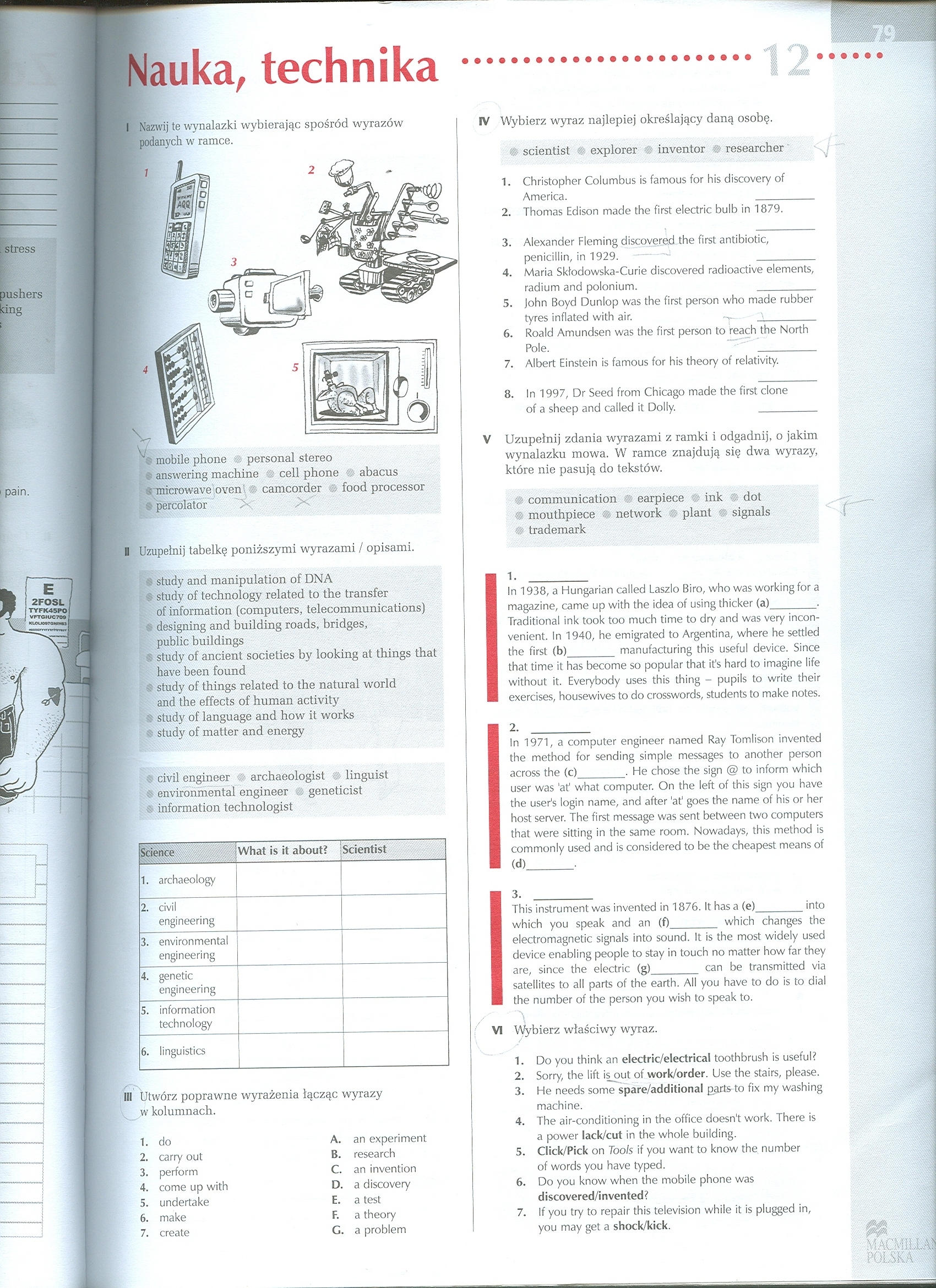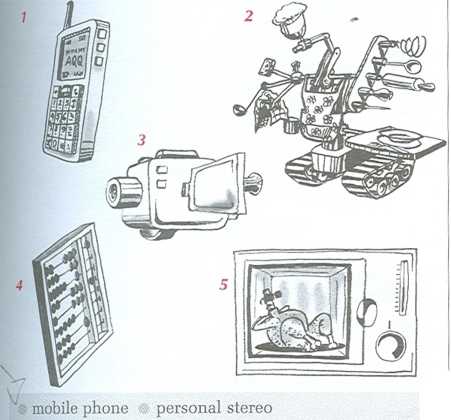21132 skanuj0025 (122)

Nauka, technika
|
Science |
What is it about? |
Scientist |
|
1. archaeology | ||
|
2. civil engineering | ||
|
3. environmental engineering | ||
|
4. genetic engineering | ||
|
5. information technology | ||
|
6. linguistics |
I Nazwij te wynalazki wybierając spośród wyrazów podanych w ramce.

f answering machinę celi phone abacus ; microwave oven camcorder food processor $ percolator ">
II Uzupełnij tabelkę poniższymi wyrazami / opisami.
•5 study and manipułation of DNA § study of technology related to the transfer of information (computers, telecommunications)
: designing and building roads, bridges, public buildings
: study of ancient societies by looking at things that have been found
J study of things related to the natural world and the effects of human activity study of language and how it works : study of rnatter and energy
civil engineer archaeologist linguist environmental engineer geneticist information technologist
III Utwórz poprawme wyrażenia łącząc wyrazy W kolumnach.
|
1. |
do |
A. |
an experiment |
|
2. |
carry out |
B. |
research |
|
3. |
perform |
C. |
an invention |
|
4. |
come up with |
D. |
a discovery |
|
5. |
undertake |
E. |
a test |
|
6. |
make |
F. |
a theory |
|
7. |
create |
G. |
a problem |
IV Wybierz wyraz najlepiej określający daną osobę.
# scientist explorer inventor researcher
1. Christopher Columbus is famous for his discovery of
America. _
2. Thomas Edison madę the first electric bulb in 1879.
3. Alexander Fleming discovered the first antibiotic,
penicillin, in 1929. ----J _
4. Maria Sktodowska-Curie discovered radioactive elements,
radium and polonium. _
5. John Boyd Dunlop was the first person who madę rubber
tyres inflated with air. __
6. Roald Amundsen was the first person to reach the North
Pole. _
7. Albert Einstein is famous for his theory of relativity.
8. In 1997, Dr Seed from Chicago madę the first clone
of a sheep and called it Doiły. _
V Uzupełnij zdania wyrazami z ramki i odgadnij, o jakim wynalazku mowa. W ramce znajdują się dwa wyrazy, które nie pasują do tekstów.
communication earpiece ink dot mouthpiece network plant signals trademark
In 1938, a Hungarian called Laszlo Biro, who was workingfor a
magazine, came up with the idea of using thicker (a)_.
Traditional ink took too much time to dry and was very incon-venient. In 1940, he emigrated to Argentina, where he settled
the first (b)_ manufacturing this useful device. Since
that time it has become so popular that it's hard to imagine life without it. Everybody uses this thing - pupils to write their exercises, housewives to do crosswords, students to make notes.
2. _
In 1971, a Computer engineer named Ray Tomlison invented the method for sending simple messages to another person
across the (c)_. He chose the sign @ to inform which
user was 'at' what Computer. On the left of this sign you have the user's login name, and after 'at' goes the name of his or her host server. The first message was sent between two computers that were sitting in the same room. Nowadays, this method is commonly used and is considered to be the cheapest means of (d)_.
I This instrument was invented in 1876. It has a (e)_into
which you speak and an (f)_ which changes the
electromagnetic signals into sound. It is the most widely used device enabling people to stay in touch no rnatter how far they
are, sińce the electric (g)_ can be transmitted via
satellites to all parts of the earth. Ali you have to do is to dial the number of the person you wish to speak to.
VI Wybierz właściwy wyraz.
1. Do you think an electric/electrical toothbrush is useful?
2. Sorry, the lift is out of work/order. Use the stairs, please.
3. He needs some spare/additional pąrTs-to fix my washing machinę.
4. The air-conditioning in the office doesn't work. There is a power lack/cut in the whole building.
5. Click/Pick on Tools if you want to know the number of words you have typed.
6. Do you know when the mobile phone was discovered/invented?
7. If you try to repair this television while it is plugged in, you may get a shock/kick.
Wyszukiwarka
Podobne podstrony:
łSL (( Live Science,What is a Higgj The elu$ive Htggs boson. if found. would complete the Standard M
122 Yci ypOKM 3Hr/iii/icbKOi mobu. 5 K/iac (3a niflpyHHMKOM O. Kapn iOK)Gamę "What is it? Guess
41:19WYMAGANY WYNIK TESTU IELTS news
„Weil, good, but what is it good for?", asked on engineer in the IBM Deveiopr, Department about
40621 PG? what is it Potrzebne będą: •nożyczki, •kredki. Imię_CO TO JESTf W chmurkach znajdują
Communication skills questions-what is important about them? Telephone Skills Thlnklng through In
50853 WELCOME KIDS 2 ANGIELSKI ZESZYT ĆWICZEŃ 28 4 aeroplane/helicopter 5 bat/ball 6 car/bus0 Read
a 1) Climate Change (What is it?) Earth has warmed by about 1°F over the past 100 years, But why? A
A look atblockchain technology What is it? The blockchain is a decentralized ledger of all transacti
skanuj0059 122 Resocjalizacja przestępców seksualnych 4.2.3.2. Korygowanie wadliwych reakcji oraz na
skanuj0003(1) 2 • ■Geodezja to nauka i technika zajmująca się pomiarami oraz badaniami rozmiarów i k
with what is going on here. If we limit the Conference to just, so to say, very technical aflairs we
więcej podobnych podstron